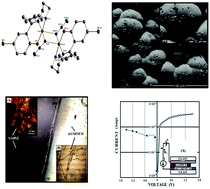Azido bridged binuclear copper(ii) Schiff base compound: synthesis, structure and electrical properties†
Abstract
An azido bridged dinuclear complex [Cu(L−)(μ1,1N3)]2 (1) was synthesized by a 1 : 1 condensation of N-cyclohexyl-1,3-propanediamine and 5-bromosalicylaldehyde (HL). The complex was subsequently characterized based on elemental analyses, IR, single-crystal X-ray diffraction, a Hirshfeld study, FESEM, ESI-MS, powder XRD and also DFT studies successfully. The X-ray crystal structure of complex 1 revealed that the Cu(II) ion exhibited a definite five-coordinate square pyramidal coordination arrangement with a centro-symmetric μ 1,1-azido bridging in the end-on mode and formed a dimeric structure. The optical direct band gap of complex 1 was estimated to be 2.84 eV. The current–voltage characteristics of the Al/1/ITO structure were analyzed considering the thermionic emission theory of the Schottky barrier diode. The transient behaviour of the test structure was found to be interesting as it showed explicit frequency-selective phenomena. In view of an application-specific perspective for the material, compound 1 can be exploited as an electronic material for the development of electronic filters.



 Please wait while we load your content...
Please wait while we load your content...